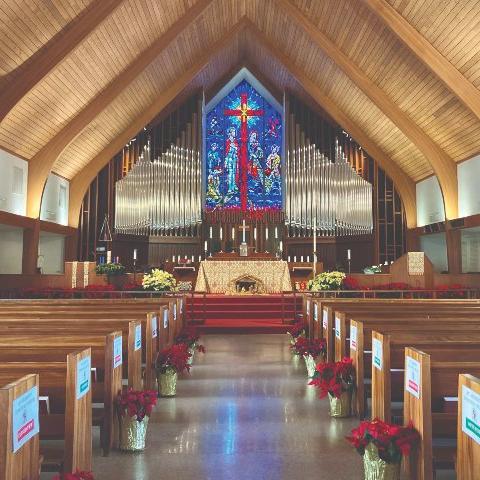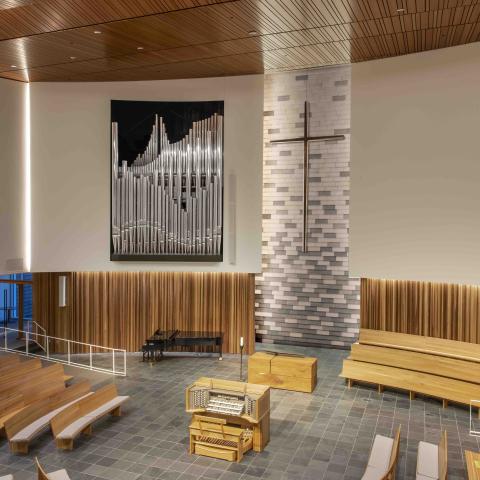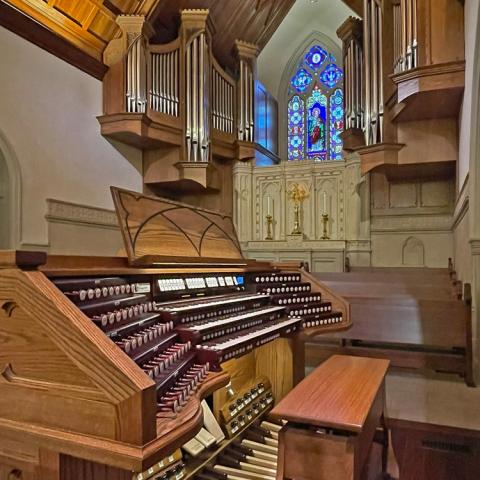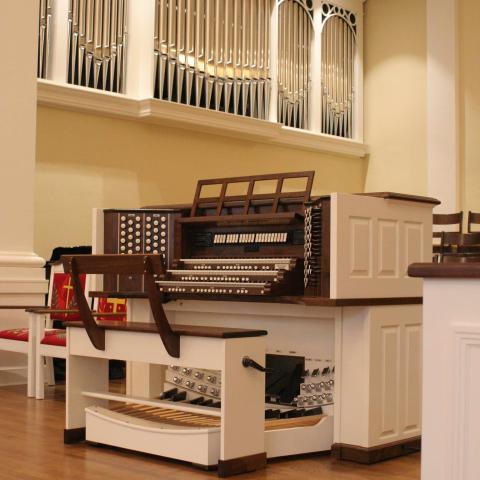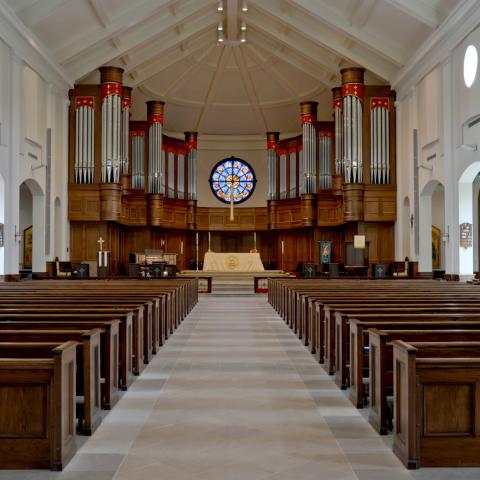A. E. Schlueter Pipe Organ Co., Lithonia, Georgia; St. Simons Island Presbyterian Church, St. Simons Island, Georgia
Arthur E. Schlueter, III, Visual and Tonal Direction, A. E. Schlueter Pipe Organ Co.
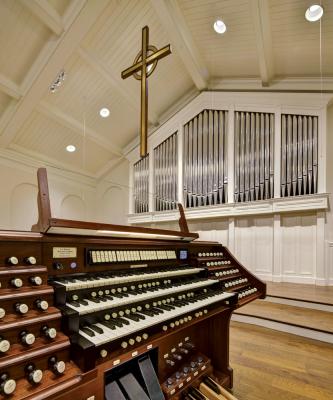
St. Simons Island is a coastal community with roots that include coastal Indian tribes, the Spanish occupation, pre-Revolutionary War America as part of the original American colonies, and John and Charles Wesley preaching on this island under the majestic oak trees. In more recent years it has developed into a coastal retreat that is known colloquially as part of the Golden Isles. As a point of reference, this part of Georgia has been a place of retreat and reflection for the Schlueter family for years.
It is in this setting that our work with St. Simons Island Presbyterian Church began several years ago. The original organ, built in 1984, was a modest 23 ranks in size divided up into a three-manual specification. It was prepared for a number of additions that had not been completed. Unfortunately, the environment of an island location can prove difficult on mechanical systems, and the console was failing. With its condition and reliability in question, the church sent out a query about replacing it with a new console and replacement of its electrical system and relays.
As we met with the church about the organ, we discussed their current needs as well as future plans and aspirations. Central to their planning was a major architectural change and enlargement of the church. While this would possibly be years in the offing, we knew that future needs had to be framed into our design of a replacement console.
We built a three-manual terraced console that would be able to control the then-present specification but also would be prepared for a new future instrument and enhanced specification. Its low profile allowed an easy sightline to the choir and congregation, which the former console never had, and portability with inbuilt castors. The console was built of mahogany with oblique drawknobs turned out of African blackwood. The control system we used allowed us to support the former specification, and could easily be programmed to support a larger and differing specification in the future.
It would be several years between the installation of the new console and the rebuilding of the church, but with the passage of time this became a reality. Our staff worked with the church architect to redesign the center organ space for a larger, more complete instrument.
When the church moved forward to renovate and enlarge their sanctuary, the future plans that we considered when the new console was built proved fruitful as a guide to the design of the new organ in its specification and space requirements.
The design of the new church sanctuary sought to use the basic shell and core of the church while providing a much more expansive chancel and wider transepts. This was achieved with additional seating while keeping a worship space that feels intimate.
The former instrument did not have any visible pipes and was behind a grille. Early on it was decided that there would be a visual element in the new organ with the inclusion of speaking façade pipes.
The visual design of the organ was two-fold; the lower portion of the organ case was to act as a rear wall to focus the choir, the upper portion of the case has a cantilever that not only breaks up the flat planes of the organ case but allows us a slight shelf to sonically project the organ forward of the choir, clergy, and cele-brants. The people in the chancel can hear the organ, but importantly do not have to take the brunt of the organ during large congregational registrations.
The ceiling height in the church did not allow for 16′ pipes. We designed the pipes to be overlength and back-slotted to give the 8′ Principal and 8′ Octave more loft than the façade otherwise would have had. The organ case pipes are built of polished aluminum and follow the fall of the ceiling. The varying-length toes of the façade pipes provide a gentle reinforcement to the other arcs in the sanctuary. The polished pipes do not act like mirrors; rather, they take on and subtly reinforce the natural lighting hues of the church. The end result of design is a pipe façade and case that not only is acoustically functional for the organ but also one that forms an elegant visual backdrop for the suspended cross.
To support tuning stability, the interior layout of the organ was designed to place the majority of the pipework on the same thermocline. The divisions’ orientation has the Swell on the left, the Great in the center with the Choir behind it, and the Pedal on the right. The expression boxes were designed to allow the organist to hear the entire range of degrees of expression through bi-directional use of the expression shades with multiple expression motors. This allows the organist to hear the organ in the same fashion it is heard by the congregant in the pews.
The new specification we designed was to have more tonal resources for choral and congregational accompaniment, more specification weight around an 8′ pitch center, and additional palettes of color. For use with choir and soloist, we envisioned an instrument with a large number of resources under expression. This allows even large registrations to be fully contained when text painting under the choir.
We knew that the church would use the instrument in outreach through public concerts with choir and organ. While the organ is fundamentally designed to support the music needs of the church service, the island that this church sits on supports a population with a rich arts community. In addition to the sacred use of the organ, we sought an enhanced ability to support a wider body of organ repertoire of many different periods and styles.
The new organ incorporates pipes from the previous instrument. This is an important consideration that we give gravity to in all of our work. Consider the gifts required to build an instrument. The generous people who give these gifts should have every hope and wish that their gifts continue to be honored. We cannot say it enough, stewardship is important.
Accordingly, in studying the previous instrument, we found that through divisional shifting of resources, along with revoicing, repitching, and/or rescaling, that much of the pipework could and should be retained. In all about one-third of the resources in the previous organ were able to find a home in the new instrument. The final specification is 38 ranks with resources and colors that eclipse the previous instrument.
The Great division was designed with a well-developed principal chorus with the 8′ and 4′ flute registers as thickening agents. The 4′ Hohlflöte in the Great is a chameleon that can take its place in the ensemble or be very effective as a solo device with the appropriate treble ascendance. The reeds of the Great are duplexed from the Swell. In this acoustic we chose English shallots with their “ah” vowel cavity that proves very friendly in this acoustic. The Swell division features side opening shades into the Great to provide equanimity of speech between the Great chorus and added reeds when used together. The Great has a second 8′ principal (Geigen Principal) that can be added for larger registrations to support robust congregational singing.
An unusual feature in the organ is the number of mutations. As discussed previously, we knew color to be important. The rich 2-2⁄3′, 1-3⁄5′, and 1-1⁄3′ pitches allow the large number of registers differing accents and solo devices with their use. Importantly, the parallel borrows of the 1-1⁄3′ pitches from the 2-2⁄3′ in the Swell and Choir provide the building of “mixture texture” in the Swell and Choir without aggression. The ability to fold in unweighted treble ascendance prior to registering the chorus mixtures allows a more seamless buildup of the organ crescendo.
The strings in the Swell and the Choir individually provide the necessary ether when required and when coupled together and drawing in the 8′ Muted Violes and the 8′ Vox Humana make an effective enclosed string organ. Again, in tipping our hat to a duality in stop design, the scale of the strings in both divisions allows them to act as small anchoring principals to the enclosed division choruses when drawn and thickened with the 8′ flute registers.
The Pedal has several independent registers to support the independent contrapuntal voice. We also provided a number of manual-to-pedal duplexes to provide additional grounding to the pedal. Because of space requirements, we utilized custom digital voices for 1–12 of the 32′ registers and for 1–12 of the 16′ Principal. These digital stops are voiced to seamlessly fold into the pipe resources.
While we did save some pipework, our experience with the organ, guided by the current organ curator, convinced us that a new chassis should be considered. The church sits on an island with extremes of humidity, and there had been seasonal problems with the organ chassis in conjunction with the regular environmental changes. The new chassis included all new electro-pneumatic slider windchests, new unit windchests, a new winding system, new support structure, and new expression boxes and swell shades. The aforementioned console and relays built by our firm were recast for the new specification.
Just as we prepared for growth when we built a new console years ago, there are plans for additional growth. The console has controls for a Fanfare division that will provide additional foundation for congregational support and allow the addition of a solo reed. While not only visually dramatic, the solo reed, when added, will provide the appropriate “sending” for the numerous weddings hosted at this church.
The organ was built and installed during the pandemic. I know that all of us have differing trials that occurred during this period of time. We were fortunate to have such a supportive church to work with along with supportive family and staff. We simply could not have accomplished the building and installation of this instrument without the help of so many. Their thoughts, prayers, and aspirations sustained and supported us. In the midst of the organ installation we were onsite during Ash Wednesday. With the fresh imposition of ashes on our foreheads, we were reminded that we come from dust and to dust we will return. It was comforting to know that as we take our place in history, our work will outlive us and continue to support the ministry, music, and worship at this church.
The members of this community of faith are to be commended for their dedicated and hard work. They sought to both preserve a worship space that was known while recasting it into a fundamentally new church. They diligently worked to provide a space that acoustically supports music and spoken word. In their work they excelled brilliantly. Accordingly, in addition to my family and staff, I want to single out: Rev. Alan Dyer, pastor; Rhonda Hambright, director of music; Amy Bishop, organist; James Freeman, instrument curator; Tom Baltzell, chair, building committee; Matt Hodgdon, building committee; Karen Schmidt, building committee; Robert Ussery, Ussery-Rule Architects; Cory Rule, Ussery-Rule Architects; Joe Combs, project manager, Ussery-Rule Architects; Tracy Morelan, design architect, Ussery-Rule Architects; Dee Davis, decorator; Ryan and Rand Tyson, owners, Tyson Construction Company; Chuck Miller, superintendent, Tyson Construction Company; members and friends of St. Simons Island Presbyterian Church.
The building of any instrument demands the efforts of a talented and dedicated team. Our team includes: Arthur E. Schlueter, Jr., Arthur E. Schlueter, III, John Tanner, Marc Conley, Patrick Hodges, Jeremiah Hodges, Marshall Foxworthy, Peter Duys, Bob Weaver, Kerry Bunn, Al Schroer, Shan Dalton-Bowen, Michael DeSimone, Dallas Wood, Josey Davis, Preston Wilson, Clifton Frierson, Kelvin Cheatham, Ruth Lopez, Sara Cruz, Ruth Gomez, and Yolanda Sandoval.
Visit www.pipe-organ.com for more information or to contact A. E. Schlueter Pipe Organ Company.
Photo credit: Harlan Hambright
GREAT (Manual II)
16′ Pommer (Choir)
8′ Principal 61 pipes
8′ Geigen Principal 49 pipes (1–12 Pedal Principal)
8′ Bourdon 61 pipes
4′ Octave 61 pipes
4′ Hohlflöte 61 pipes
2-2⁄3′ Twelfth (TC) 49 pipes
2′ Super Octave 61 pipes
1-3⁄5′ Seventeenth (TC) 49 pipes
1-1⁄3′ Mixture III–V 281 pipes
Tremulant
16′ Contra Fagotto (Swell)
8′ Trumpet (Swell)
Chimes (Choir)
Zimbelstern
CHOIR (Manual I, enclosed)
16′ Pommer 61 pipes
8′ Holzgedeckt 61 pipes
8′ Erzahler 61 pipes
8′ Erzahler Celeste (TC) 49 pipes
4′ Weit Principal 61 pipes
4′ Gedeckt Pommer (ext 16′) 24 pipes
2-2⁄3′ Nasat (TC) 49 pipes
2′ Klein Octave 61 pipes
1-3⁄5′ Terz (TC) 49 pipes
1-1⁄3′ Quint (ext Nasat) 12 pipes
1′ Sifflöte (ext 16′ Pommer 12 pipes (top octave repeats)
II Carillon (from 1-1⁄3′ and 1-3⁄5′)
8′ Krummhorn 61 pipes
Tremulant
SWELL (Manual III, enclosed)
16′ Contra Viola (TC, from 8′ Viola)
8′ Viola da Gamba 61 pipes
8′ Viola Celeste (TC) 49 pipes
8′ Muted Violes II (digital)
8′ Rohrflöte 61 pipes
4′ Principal 61 pipes
4′ Koppelflöte 61 pipes
4′ Unda Maris II (digital)
2-2⁄3′ Nazard (TC) 49 pipes
2′ Flageolet 61 pipes
1-3⁄5′ Tierce 61 pipes
1-1⁄3′ Quint (ext Nazard) 12 pipes
2′ Plein Jeu III–IV 232 pipes
16′ Fagotto 61 pipes
8′ Trumpet 61 pipes
8′ Fagotto (ext 16′ Fagotto) 12 pipes
4′ Fagotto Clarion (ext 16′) 12 pipes
8′ Vox Humana (digital)
Tremulant
FANFARE (digital, prepared for pipes)
8′ Principal
8′ Flute Celeste II
4′ Octave
2′ Doublette
8′ Trompette en Chamade
Fanfare On Great
Fanfare Off Choir
PEDAL
32′ Untersatz (digital)
16′ Principal (digital)
16′ Subbass 32 pipes
16′ Pommer (Choir)
8′ Principal 32 pipes
8′ Subbass (ext 16′ Subbass) 12 pipes
4′ Choral Bass (ext 8′ Princ) 12 pipes
4′ Gedeckt Pommer (Choir)
32′ Contra Fagotto (digital)
16′ Posaune (ext, Sw 8′ Tpt) 12 pipes
16′ Fagotto (Swell)
8′ Trumpet (Swell)
4′ Clarion (Swell)
4′ Fagotto Clarion (Swell)
Couplers
Swell to Great 16
Swell to Great 8
Swell to Great 4
Choir to Great 16
Choir to Great 8
Choir to Great 4
Choir to Choir 16
Choir Unison Off
Choir to Choir 4
Swell to Choir 16
Swell to Choir 8
Swell to Choir 4
Swell to Swell 16
Swell Unison Off
Swell to Swell 4
Choir to Swell 8
MIDI to Pedal
MIDI to Great
MIDI to Swell
MIDI to Choir
38 ranks, 2,248 pipes

